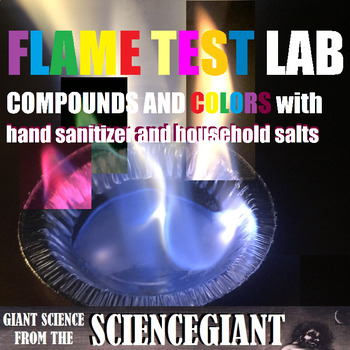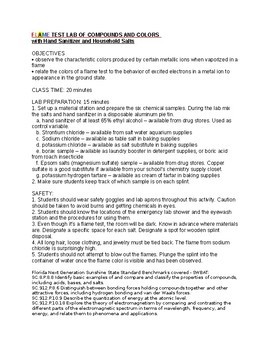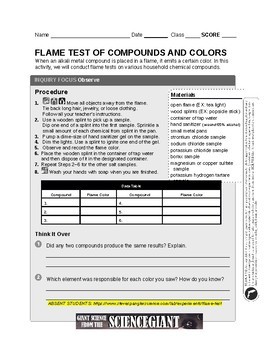Flame Test Lab of Compounds and Colors with hand sanitizer and household salts
- Word Document File
Description
Flame Test of Compounds and Colors is a low cost lab demonstration to fire up your students. This chemistry lab uses hand sanitizer and household chemicals of sodium chloride (table salt), potassium chloride (salt substitute), sodium borate (insecticide with borax acid) and potassium hydrogen tartare (cream of tartar) in a safe and fun fiery introduction to compounds! Excite electrons and ignite your students interest in elements with this demonstration of red, orange, yellow, green, blue, and purplish flames.
This product includes both the lab worksheet and answer key, with a recommended video for review. And it's in Microsoft Word .doc form so that Ts can customize the discussion to fit the needs of their Ss.
Also includes an infographic on the colors in fireworks stem from a wide variety of metal compounds – particularly metal salts. In chemistry ‘salt’ refers to any compound that contains metal and non-metal atoms ionically bonded together. So, using this lab as background, ask Ss how do these compounds give the huge range of colors to produce fireworks? This graphic looks at the color of various metal and metalloid ions that occur during flame tests.
Objectives:
By the end of this demonstration, students should be able to
- Use flame tests to identify a metal or metallic salt by the color that it produces when it is put into a flame.
- Calculate the frequency of light given its wavelength.
- Calculate the wavelength of light given its frequency.
This activity is classroom tested to help students with the following Florida Next Generation Sunshine State Standards in Science:
Students Will Be Able To (SWBAT/I Can):
• SC.8.P.8.8 Identify basic examples of and compare and classify the properties of compounds, including acids, bases, and salts.
• SC.912.P.8.6 Distinguish between bonding forces holding compounds together and other attractive forces, including hydrogen bonding and van der Waals forces.
• SC.912.P.10.9 Describe the quantization of energy at the atomic level.
• SC.912.P.10.18 Explore the theory of electromagnetism by comparing and contrasting the different parts of the electromagnetic spectrum in terms of wavelength, frequency, and energy, and relate them to phenomena and applications.
Related Resources
__________
Help others #StandOnTheShouldersOfGiants -- leave a review for this resource! And it helps you #SeeFurther too -- you earn 1 credit for every $1 spent on TpT resources. Each credit has a value of 5 cents, so 20 credits earned equals $1 to apply to future TpT purchases.
#StayGiant and stay up on my new resources and STEM news. Look for the green ★ star near the top of any page within my store and click "FOLLOW". Or follow @TheScienceGiant Twitter. Stand on the Shoulders of Giants, and together we'll see further, inspire students, and enlighten inquisitive minds!





